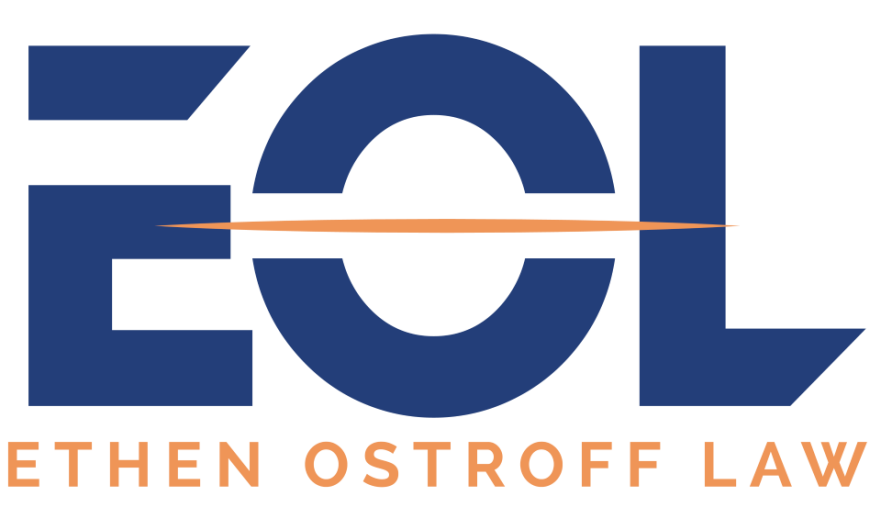Artificial Turf Cancer Lawsuit | Addressing Health Risks from Exposure
Artificial turf has become a popular choice for low-maintenance landscapes, sports fields, and playgrounds, offering an alternative to natural grass. However, concerns about potential health risks, including those raised in artificial turf cancer lawsuit, have surfaced. In this guide, Ethen Ostroff Law explores the makeup of artificial turf, sheds light on specific concerns about crumb rubber, examines the possible link between artificial turf and cancer, and provides guidance on the process of filing a lawsuit.
A Snapshot of Artificial Turf Evolution
Artificial turf, also called astroturf or synthetic grass, is a surface crafted from synthetic fibers to imitate natural grass. Originating in the 1950s, scientists explored synthetic alternatives, leading to the introduction of Astroturf by Monsanto in the 1960s. Initially used in sports stadiums, it gained popularity for its durability. Despite expanding to various settings in the 1970s and 1980s, early versions lacked a natural feel.
Advancements in the 1990s brought improved systems with longer fibers and better drainage. The 2000s marked the third generation, featuring softer fibers and standardized infill materials like rubber and sand. Today, artificial turf is versatile and is found in sports fields, residential lawns, playgrounds, and commercial spaces. Environmental concerns led to innovations like recycled rubber infill and eco-friendly turf.
Despite widespread use, ongoing research focuses on health concerns, especially those related to crumb rubber infill. The history of artificial turf reflects a journey of continuous innovation, balancing functionality with environmental and safety considerations.
Common Uses of Artificial Turfs
Artificial turf has a wide range of residential and commercial applications. Here are some common uses of artificial turf:
Residential applications
- Balconies, decks, patios, and outdoor living spaces: Artificial turf provides a natural, green aesthetic to outdoor living spaces where real grass may be impractical to grow.
- Dog runs, dog potty areas, and pet turf: Artificial grass is used to create pet-friendly areas for dogs, providing a smooth and clean surface.
- Indoor decor: It can be used indoors as a decorative element, adding texture and color to spaces such as offices, entryways, and lobbies.
- Play areas: It offers a safe and cushioned surface for children to play on, reducing the risk of trips and falls.
Commercial and recreational applications
- Business landscaping: Many businesses use artificial turf to enhance their properties, as it requires minimal maintenance and provides an attractive appearance year-round.
- Indoor use: Artificial turf can be used indoors for various purposes, such as gym flooring, decorative elements, and photo backdrops.
- Sports fields and playgrounds: Artificial turf is commonly used on sports fields and playgrounds due to its durability, low maintenance, and cushioning properties, reducing the risk of injuries.
Other unconventional uses
- Driveways: Artificial turf can be used to add greenery to driveways, providing a unique and visually appealing alternative to traditional paving.
- Pool surrounds: It can be used around pools to create a natural and comfortable surface.
- Vehicle coverings: Artificial turf can be used to cover vehicles, adding a unique and eye-catching aesthetic.
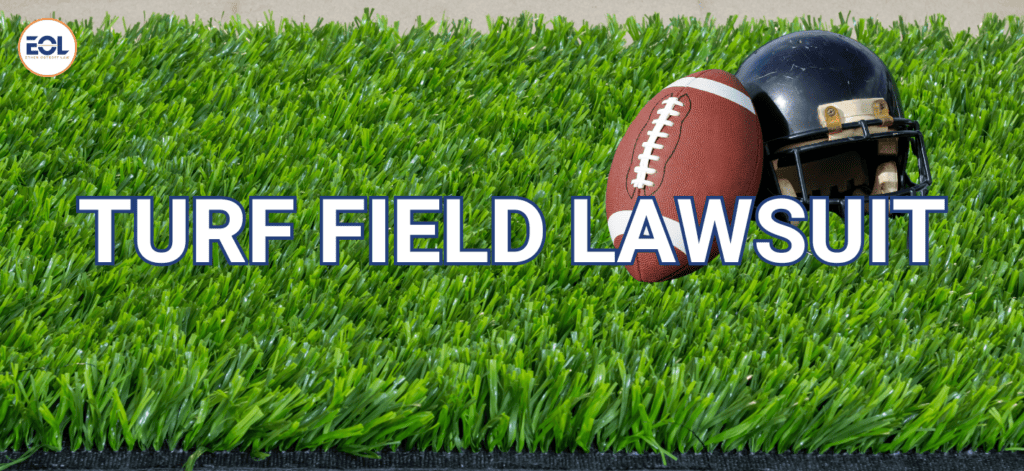
Composition of Artificial Turf
Artificial turf is crafted from synthetic fibers to mimic natural grass. Its key components include:
- Blades of grass: Typically made of nylon, polypropylene, or polyethylene, these synthetic fibers are intricately manufactured to closely resemble the appearance and texture of natural grass.
- Backing material: This essential component binds all the grass blades together, providing stability and support for the synthetic fibers.
- Infill material: Some artificial turfs use infill materials like silicon sand or granulated rubber, known as “crumb rubber.” The infill serves to cushion and support synthetic grass blades. Crumb rubber infill, often made from recycled car tires, may contain substances like heavy metals, PFAS chemicals, and other environmental concerns.
Hazardous Chemicals in Artificial Turf
Artificial turf has sparked concerns because of the presence of harmful chemicals, raising worries about possible effects on health and the environment. Common chemicals found include:
- Heavy metals: Crumb rubber infill, often made from recycled tires, may contain heavy metals like lead, cadmium, chromium, and nickel, posing serious health risks.
- Per- and polyfluoroalkyl substances (PFAS): These chemicals have been identified in synthetic turf, raising worries about potential health risks and environmental impacts.
- Phthalates: Studies discovered these harmful substances in artificial turf, known for their impact on human health, sparking concerns about possible exposure.
- Polycyclic aromatic hydrocarbons (PAHs): These compounds known to cause cancer were found in artificial turf, raising worries about potential health risks.
Crumb Rubber, PFAS, and Lead in Artificial Turf: The Main Concerns
On the issues surrounding artificial turf, three major concerns stand out:
- Crumb rubber: This recycled material from old tires is used in playgrounds and artificial turf fields to reduce tire waste. However, worries about health risks have led to scientific research. An study identified 197 predicted carcinogens out of 306 chemicals found in crumb rubber. Notably, 52 were already classified as carcinogens by environmental agencies, including benzene, benzidine, benzo(a)pyrene, trichloroethylene, and vinyl chloride.
- PFAS: Some artificial turfs contain PFAS, raising concerns about health risks, including cancer. Long-term exposure to PFAS is linked to serious health issues such as various cancers, decreased fertility, liver problems, high cholesterol, immune system issues, pregnancy-induced hypertension, and thyroid disease.
- Lead: Added for color and durability, lead in synthetic turfs can become a health concern as it’s released through weathering, sunlight, and wear. Exposure to lead from turf surfaces can impact neurological development, cognitive function, cardiovascular health, reproductive health, and overall well-being in both children and adults.
Exposure to Artificial Turf and Associated Health Risks
Being around artificial turf, particularly the chemicals in crumb rubber infill, has stirred notable concerns about potential public health risks, including:
- Cancer risks: Chemicals in artificial turf, including PAHs, PFAS, and phthalates, are known as carcinogens, endocrine disruptors, mutagens, and neurotoxicants, raising concerns about the potential risk of cancer from artificial turf exposure.
- Endocrine disruption: Certain chemicals in artificial turf, including phthalates, disrupt the endocrine system, possibly leading to developmental and reproductive problems.
- Heavy metal exposure: The crumb rubber infill in artificial turf may contain heavy metals like cadmium, chromium, lead, and nickel, known for posing serious health risks.
- Neurological and respiratory effects: Being close to artificial turf has been associated with neurological and respiratory effects, causing symptoms like dizziness, headaches, and respiratory irritation.
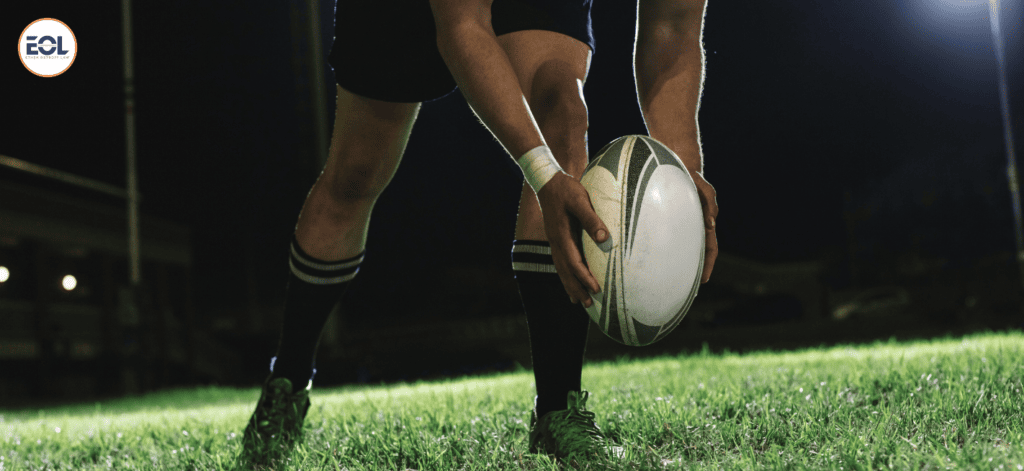
Artificial Turf and Cancer
Ongoing research and discussions surround the potential health risks, including cancer, associated with artificial turf. While specific cancers directly caused by artificial turf remain uncertain, studies suggest a possible connection between exposure to certain components, like those in crumb rubber infill, and an increased cancer risk. The cancers mentioned in these studies include:
- Hodgkin’s lymphoma (and non-Hodgkin’s lymphoma): A common cancer linked to crumb rubber exposure, affecting white blood cells, and weakening the immune system.
- Leukemia: Some studies explore a potential link between exposure to certain artificial turf chemicals and an elevated risk of leukemia.
- Lung cancer: Concerns arise from inhaling airborne particles, especially from crumb rubber infill, raising potential respiratory health risks, including lung cancer.
- Skin cancer: Prolonged contact with artificial turf surfaces may contribute to an increased risk of skin cancer, particularly if the turf contains substances harmful to the skin.
Who Is Vulnerable to Potential Risks?
While ongoing research explores the overall risk, specific groups could face higher potential risks linked to artificial turf. It’s crucial for the following individuals and communities to stay informed and take the necessary precautions:
- Athletes: Regular users in sports settings might have elevated potential health risks due to prolonged exposure and physical activity.
- Children: Kids, often playing on turf, may have more direct contact. Developing immune systems and hand-to-mouth behaviors can increase susceptibility to potential risks.
- Communities in warm climates: Artificial turf can become significantly hotter than natural grass, posing an increased risk of heat-related issues for those using it in warm conditions.
- Frequent users: Individuals spending extended periods on artificial turf may face higher exposure, potentially contributing to health issues over time.
- Groundskeepers and maintenance personnel: Those in continuous contact with turf materials during installation, maintenance, or repair may be at occupational health risk due to potential substance exposure.
- Individuals with pre-existing health conditions: Exposure to artificial turf can potentially exacerbate pre-existing health conditions.
Safeguarding Against Harmful Substances in Artificial Turfs
While conclusive evidence is still pending, taking precautions for yourself and your loved ones when on artificial turf is a wise approach. Here are some suggestions to potentially reduce exposure:
- Advocate for research and regulation: Supporting more extensive research and regulation on crumb rubber use in artificial turf fields advocates for the safety of athletes and users.
- Avoid ingestion: Refrain from eating or drinking on or near artificial turf fields to reduce the risk of ingesting harmful chemicals.
- Choose alternative materials: Exploring alternatives, such as organic infills or natural grass, can potentially decrease the risk of exposure to harmful chemicals.
- Use protective equipment: Athletes using artificial turf fields might consider protective gear like gloves and masks to lower the risk of exposure to harmful chemicals.
- Wash hands and clothes: After contact with crumb rubber, ensure thorough handwashing and clothes cleaning to minimize the risk of ingesting or inhaling harmful chemicals.
Your Health and Legal Options
For individuals concerned about the potential health risks associated with artificial turf, there are several proactive steps to take:
- Consult healthcare professionals: If you suspect health issues related to artificial turf exposure, seek advice from healthcare professionals for a thorough evaluation.
- Document health issues: Keep detailed records of any health problems you or your loved ones may be experiencing due to artificial turf exposure. This information can be crucial when pursuing legal action.
- Legal recourse: If you believe your health issues are a result of exposure to hazardous substances in artificial turf, consider consulting with a personal injury lawyer to explore potential legal options.
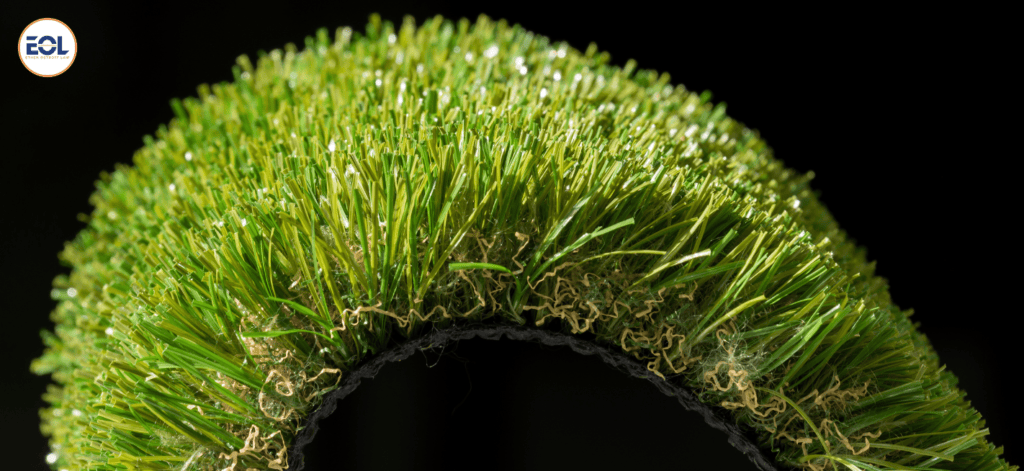
Artificial Turf Cancer Lawsuit
The artificial turf cancer lawsuit involves legal actions and investigations connected to potential health risks from exposure to artificial turf, focusing on harmful chemicals and a potential link to cancer. These cases raise concerns about toxic compounds like benzene, lead, mercury, PAHs, PFAS, and other heavy metals in artificial turf, along with the possible health risks. Litigators nationwide are investigating potential class actions against turf manufacturers on behalf of those exposed to these substances. While a definitive link between artificial turf and heightened cancer risk hasn’t been established, ongoing research is essential to fully grasp potential health concerns tied to artificial turf.
Lawsuits Over Artificial Turf Exposure
- In a March 2023 report by the Philadelphia Inquirer, a potential connection between a rare brain cancer, glioblastoma, and turf fields was highlighted. Six former Philadelphia Phillies players, who spent much of their careers on a turf field from 1971 to 2003, all succumbed to glioblastoma. PFAS in the artificial turf is suggested as a possible cause, with testing revealing 16 types of PFAS on the old Phillies’ field. While the link is anecdotal, lawyers are using this story to attract clients for “artificial turf cancer” litigation.
- In 2008, California Attorney General Edmund G. Brown Jr. filed lawsuits against artificial turf manufacturers AstroTurf LLC, Beaulieu Group LLC, and FieldTurf USA Inc. The lawsuits claimed these companies knew about lead in their products but failed to warn Californians, violating Proposition 65. This proposition mandates warnings about known carcinogens. The lawsuits alleged that contact with turf could expose people to lead, impacting health over time. In 2009 and 2010, the manufacturers settled, agreeing to reformulate their products with minimal lead and replacing older turf with high lead content for free or at a substantial discount. Your well-being matters, and understanding these legal actions is vital as we navigate concerns surrounding artificial turf exposure.
Synthetic Turf Cancer Lawsuit Eligibility
Individuals who’ve been diagnosed with cancer and have a history of artificial grass exposure may be able to file an artificial turf cancer lawsuit to seek compensation for medical expenses and other damages.
Process for Filing an Artificial Turf Cancer Case
Filing an artificial turf cancer lawsuit involves several steps. Here’s a general guide:
- Consult with an attorney: Find a lawyer with experience in cases related to artificial turf and health issues.
- Gather information: Collect your medical records and details about the artificial turf product.
- Determine legal basis: Work with your attorney to identify the specific legal claims for your case.
- File complaint: Your attorney will draft a formal complaint and file it in court to start the legal process.
- Serve defendants: Notify the parties responsible for the artificial turf exposure about the lawsuit.
- Defendant’s response: Defendants respond to the complaint, and both parties share information through the discovery process.
- Pretrial motions and negotiations: Legal motions may be filed, and negotiations for a settlement may occur.
- Trial preparation: Prepare for trial by organizing evidence and ensuring witnesses are ready.
- Present your case in court: and the defense has a chance to respond.
- Verdict and appeal: The court or jury delivers a verdict, and either party may appeal if necessary.
- Compensation (if successful): If successful, the court may award compensation for relevant costs.
Legal Paths in Artificial Turf Exposure Cases
Legal claims in lawsuits related to artificial turf exposure often center around potential health risks linked to materials, especially crumb rubber infill. While specific claims can vary, here are potential grounds for legal action, approached with empathy:
Toxic Tort Claims
- Negligence: Asserting negligence in producing or installing artificial turf, claiming failure to warn about risks or use known harmful materials.
- Strict liability: In some areas, holding manufacturers liable for inherent dangers in the product, irrespective of fault.
- Failure to warn: Alleging insufficient warnings about potential health risks associated with artificial turf materials.
Product Liability Claims
- Defective design: Claiming that the design, especially crumb rubber infill, poses unreasonable harm.
- Defective manufacturing: Alleging improper manufacturing leads to health risks.
Breach of Warranty
- Express warranty: Pursuing claims if specific safety promises or guarantees were made.
- Implied warranty: Arguing that the product falls short of implied warranties of merchantability or fitness for a specific purpose.
Fraudulent Misrepresentation
- False advertising: Bringing claims if misleading statements about turf safety were made.
Personal Injury Claims
- Exposure-related injuries: Asserting that exposure to artificial turf chemicals caused health issues, such as cancer, respiratory problems, skin irritation, or other illnesses.
Class Actions
- Mass tort/class action lawsuits: Uniting individuals with similar claims in a collective pursuit for compensation, acknowledging shared harm from the same product.
Potential Compensation in Synthetic Turf Cancer Lawsuits
In the pursuit of justice for health issues linked to synthetic turf exposure, individuals may seek various forms of compensation. These include:
- Loss of wages: If health issues from synthetic turf exposure impact your ability to work, you may seek compensation for lost income.
- Medical expenses: Pursue compensation for current and future medical bills arising from health issues related to synthetic turf exposure.
- Pain and suffering: Seek compensation for both physical and emotional distress caused by injuries or ailments resulting from synthetic turf. The amount varies based on distress severity.
- Punitive damages: In cases of particularly negligent or malicious actions by manufacturers or distributors, courts may award punitive damages to discourage such behavior in the future.
Choose Ethen Ostroff Law
As the controversy surrounding artificial turf and its potential health risks continues to unfold, individuals need to stay informed and take necessary precautions. Ethen Ostroff Law and our partner firms are dedicated to helping those who believe they have suffered harm due to artificial turf exposure. If you or a loved one is facing health issues related to artificial turf.
What are you waiting for? Contact Ethen Ostroff Law now at 610-510-8883 ( by calling this number, you consent to receive SMS updates from Ethen Ostroff Law) or Submit Form to get free consultation.
